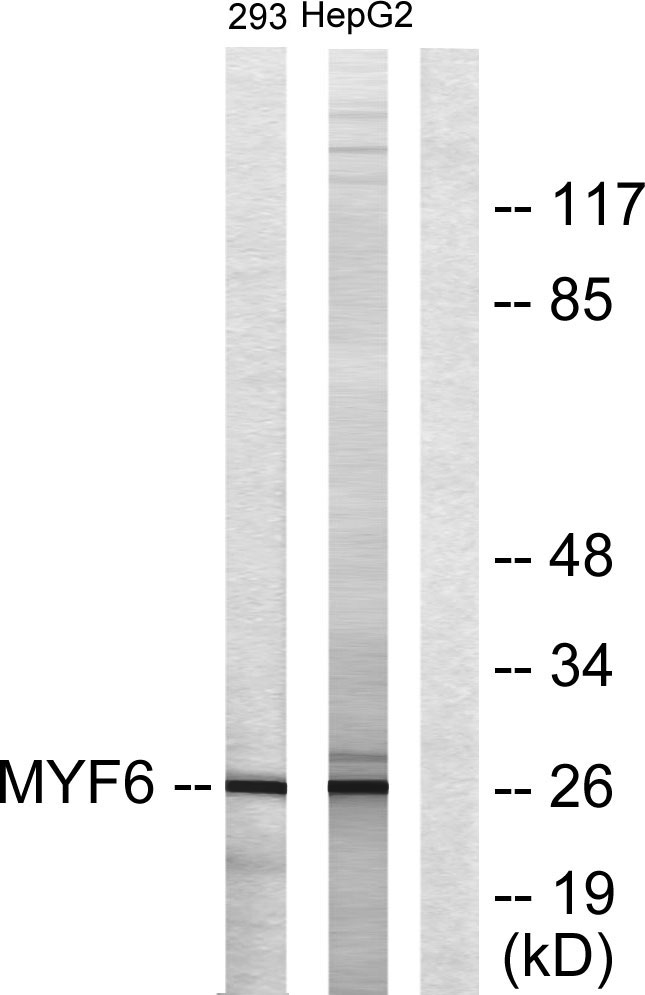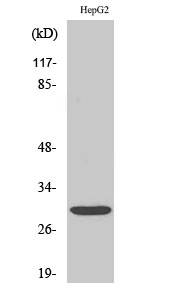产品名称
Myf-6 Rabbit Polyclonal Antibody
别名
MYF6; BHLHC4; MRF4; Myogenic factor 6; Myf-6; Class C basic helix-loop-helix protein 4; bHLHc4; Muscle-specific regulatory factor 4
存储缓冲液
Liquid in PBS containing 50% glycerol, 0.5% BSA and 0.02% New type preservative N.
Human Gene Link
http://www.ncbi.nlm.nih.gov/sites/entrez?db=gene&term=4618
Human Swissprot No.
P23409
Human Swissprot Link
http://www.uniprot.org/uniprotkb/P23409/entry
Mouse Gene Link
http://www.ncbi.nlm.nih.gov/sites/entrez?db=gene&term=17878
Mouse Swissprot No.
P15375
Mouse Swissprot Link
http://www.uniprot.org/uniprot/P15375
Rat Gene Link
http://www.ncbi.nlm.nih.gov/sites/entrez?db=gene&term=25714
Rat Swissprot Link
http://www.uniprot.org/uniprot/P19335
免疫原
The antiserum was produced against synthesized peptide derived from human MYF6. AA range:116-165
特异性
Myf-6 Polyclonal Antibody detects endogenous levels of Myf-6 protein.
稀释度
WB 1:500 - 1:2000. IHC 1:100 - 1:300. ELISA: 1:20000.. IF 1:50-200
宿主
Polyclonal, Rabbit,IgG
背景介绍
myogenic factor 6(MYF6) Homo sapiens The protein encoded by this gene is a probable basic helix-loop-helix (bHLH) DNA binding protein involved in muscle differentiation. The encoded protein likely acts as a heterodimer with another bHLH protein. Defects in this gene are a cause of autosomal dominant centronuclear myopathy (ADCNM). [provided by RefSeq, May 2010],
功能
disease:Defects in MYF6 may be a cause of centronuclear myopathy autosomal dominant (ADCNM) [MIM:160150]; also known as autosomal dominant myotubular myopathy. Centronuclear myopathies are congenital muscle disorders characterized by progressive muscular weakness and wasting involving mainly limb girdle, trunk, and neck muscles. It may also affect distal muscles. Weakness may be present during childhood or adolescence or may not become evident until the third decade of life. Ptosis is a frequent clinical feature. The most prominent histopathologic features include high frequency of centrally located nuclei in muscle fibers not secondary to regeneration, radial arrangement of sarcoplasmic strands around the central nuclei, and predominance and hypotrophy of type 1 fibers.,function:Involved in muscle differentiation (myogenic factor). Induces fibroblasts to differentiate into myoblasts. Probable sequence specific DNA-binding protein.,similarity:Contains 1 basic helix-loop-helix (bHLH) domain.,subunit:Efficient DNA binding requires dimerization with another bHLH protein.,tissue specificity:Skeletal muscle.,
纯化
The antibody was affinity-purified from rabbit antiserum by affinity-chromatography using epitope-specific immunogen.


